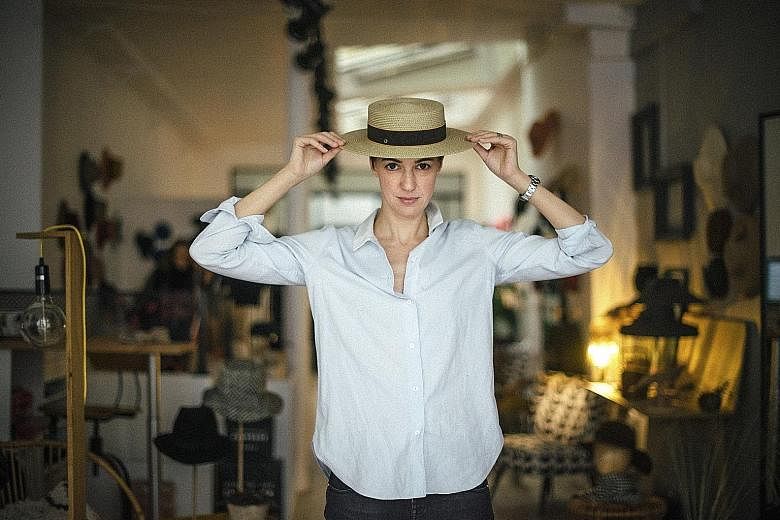PARIS• Hunched over 50-year-old sewing machines in a workshop in central Paris, milliners diligently stitch together straps of straw that grow into a spiral that grows into a hat.
The boaters, adorned with a black grosgrain band, will join the rabbit-felt fedoras, cloches and other bonnets made in the cramped atelier of Mademoiselle Chapeaux, a six-year-old brand at the forefront of a millinery renaissance.
Another is Maison Michel, one of the largest and fastest-growing high-end hat brands, which opened an in-store boutique in the department store Printemps here last month. Fans include singer Pharrell Williams, model Alexa Chung and actress Jessica Alba.
"The hat is a new means of expression. In a way, it is the new tattoo," said Ms Priscilla Royer, artistic director at the Chanel-owned brand.
Back in the 1920s, there were milliners on nearly every street corner in Paris and no self-respecting man or woman left the house without a hat.
Hats were not only status symbols, but also a gateway to the fashion world: Famous milliners who turned into full-blown fashion designers include Gabrielle Chanel (better known as Coco), Jeanne Lanvin and (two centuries earlier) Rose Bertin, Queen Marie-Antoinette's seamstress.
But after the May 1968 student riots, hats fell out of favour as French youth ditched their parents' sartorial habits as a symbol of their newfound freedom.
By the 1980s, traditional 19th-century millinery techniques like straw-hat sewing and felt-hat steaming had all but disappeared. Now they are making a comeback, powered by a new generation of hat-makers seeking to tap customers' growing appetite for the handmade and the unique.
Caroline de Maigret, one of the authors of How To Be Parisian Wherever You Are: Love, Style, And Bad Habits and a Chanel brand ambassador, said that the stigma once attached to the hat as a status symbol has almost entirely disappeared.
"A few years ago, people in Paris could think you were acting like a rock star if you wore a hat," she said. "Now, it has become more common and the fact that we live in the era of social media, where people constantly put their lives on stage, has also made wearing a hat easier."
Chloe Thieblin, who founded Mademoiselle Chapeaux in 2011, began her own production in central Paris three years ago and opened another boutique with her mother in the northern French city of Lille in 2015. Now, she said, they are doing such brisk business that she is in talks to acquire a workshop that supplies major luxury brands.
And Cerise sur le Chapeau, the Parisian milliner that offers brightly coloured rabbit-felt and straw hats with customised grosgrain bands, is setting up a workshop-boutique in Japan, one of the world's largest hat markets.
Marie Marquet, a 26-year-old milliner who created her own brand, MiniMe Paris, after earning her stripes at Maison Michel, said: "I feel that every three months, a new hat brand is being created."
Indeed, the number of hat labels presenting their wares at Premiere Classe, the accessories trade show that took place last week in Paris and is held twice a year, has nearly doubled in the past three years, organisers said.
Marquet's Tutti Frutti and Walt Disney-inspired creations have just been admitted to the Designers Apartment showroom for young designers, held during Paris Fashion Week.
Her hats, made in a Paris cellar, have become so popular, particularly among young Asian customers, that she recently started offering matching coats and dresses.
The hat market is worth around US$15 billion (S$21 billion) annually, according to market research company Euromonitor - a fraction of the global US$52-billion handbag market.
But even beyond Paris, in cities such as New York and Los Angeles where there are vibrant fashion scenes, hat-makers like Janessa Leone, Gigi Burris and Gladys Tamez are expanding fast, with orders piling in from around the world.
And retailers from Paris, London and Shanghai all said they had noticed a clear uptick in hat sales. Both the upmarket department stores Le Bon Marche in Paris, owned by LVMH Moet Hennessy Louis Vuitton, and Printemps have noticed increased demand in the past three seasons among women as well as men.
Online retailer Net-a-Porter said fedoras remained the most popular type of hats for its customers, although there recently was a notable rise in sales of caps and beanies.
"Customers are becoming increasingly adventurous and self- confident in crafting their own personal style," said Ms Lisa Aiken, retail fashion director at Net-a-Porter, now part of the Milan-listed Yoox Net-a-Porter Group.
She said hat sales were growing strongly in Asia, with revenues up 14 per cent year on year in 2016 in China.
Stephen Jones, a London-based milliner who is both founder of his own brand and the go-to designer for fashion houses, including Christian Dior and Azzedine Alaia, said he has never been busier.
"The hat is no longer about prestige; it is about looking cool, about looking now," he said. "That hat adds a bit of sparkle in what is a very grey and frightened world at the moment."
NYTIMES

